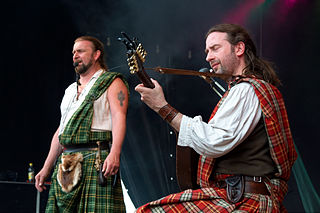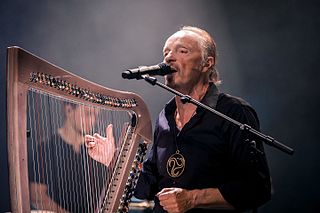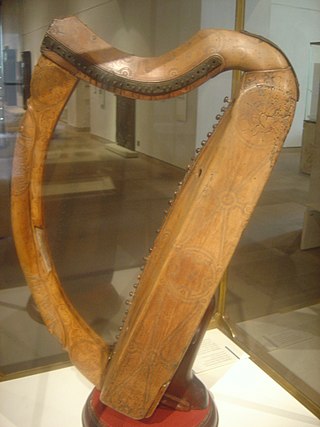
Celtic music is a broad grouping of music genres that evolved out of the folk music traditions of the Celtic people of Northwestern Europe. It refers to both orally-transmitted traditional music and recorded music and the styles vary considerably to include everything from traditional music to a wide range of hybrids.

Handfasting is a traditional practice that, depending on the term's usage, may define an unofficiated wedding, a betrothal, or a temporary wedding. The phrase refers to the making fast of a pledge by the shaking or joining of hands.
The Brobdingnagian Bards are a Celtic music group from Austin, Texas, United States.

Scottish folk music is a genre of folk music that uses forms that are identified as part of the Scottish musical tradition. There is evidence that there was a flourishing culture of popular music in Scotland during the late Middle Ages, but the only song with a melody to survive from this period is the "Pleugh Song". After the Reformation, the secular popular tradition of music continued, despite attempts by the Kirk, particularly in the Lowlands, to suppress dancing and events like penny weddings. The first clear reference to the use of the Highland bagpipes mentions their use at the Battle of Pinkie Cleugh in 1547. The Highlands in the early seventeenth century saw the development of piping families including the MacCrimmons, MacArthurs, MacGregors and the Mackays of Gairloch. There is also evidence of adoption of the fiddle in the Highlands. Well-known musicians included the fiddler Pattie Birnie and the piper Habbie Simpson. This tradition continued into the nineteenth century, with major figures such as the fiddlers Niel and his son Nathaniel Gow. There is evidence of ballads from this period. Some may date back to the late Medieval era and deal with events and people that can be traced back as far as the thirteenth century. They remained an oral tradition until they were collected as folk songs in the eighteenth century.

Secret Garden is an Irish-Norwegian band specialised in new instrumental music, led by the duo consisting of Irish violinist and singer Fionnuala Sherry and Norwegian composer, arranger and pianist Rolf Løvland.
Revival most often refers to:

The Celtic Revival is a variety of movements and trends in the 19th, 20th and 21st centuries that see a renewed interest in aspects of Celtic culture. Artists and writers drew on the traditions of Gaelic literature, Welsh-language literature, and Celtic art—what historians call insular art. Although the revival was complex and multifaceted, occurring across many fields and in various countries in Northwest Europe, its best known incarnation is probably the Irish Literary Revival. Irish writers including William Butler Yeats, Lady Gregory, "Æ" Russell, Edward Martyn, Alice Milligan and Edward Plunkett stimulated a new appreciation of traditional Irish literature and Irish poetry in the late 19th and early 20th century.
An epithalamium is a poem written specifically for the bride on the way to her marital chamber. This form continued in popularity through the history of the classical world; the Roman poet Catullus wrote a famous epithalamium, which was translated from or at least inspired by a now-lost work of Sappho. According to Origen, the Song of Songs might be an epithalamium on the marriage of Solomon with Pharaoh's daughter.
The Scottish Renaissance was a mainly literary movement of the early to mid-20th century that can be seen as the Scottish version of modernism. It is sometimes referred to as the Scottish literary renaissance, although its influence went beyond literature into music, visual arts, and politics. The writers and artists of the Scottish Renaissance displayed a profound interest in both modern philosophy and technology, as well as incorporating folk influences, and a strong concern for the fate of Scotland's declining languages.

Alan Stivell is a Breton and Celtic musician and singer, songwriter, recording artist, and master of the Celtic harp. From the early 1970s, he revived global interest in the Celtic harp and Celtic music as part of world music. As a bagpiper and bombard player, he modernized traditional Breton music and singing in the Breton language. A precursor of Celtic rock, he is inspired by the union of the Celtic cultures and is a keeper of the Breton culture.

The culture of Scotland refers to the patterns of human activity and symbolism associated with Scotland and the Scottish people. The Scottish flag is blue with a white saltire, and represents the cross of Saint Andrew.

Dan Ar Braz is a Breton guitarist-singer-composer and the founder of L'Héritage des Celtes, a 50-piece Pan-Celt band. Leading guitarist in Celtic music, he recorded as a soloist and with Celtic harp player Alan Stivell. He represented France in the Eurovision Song Contest 1996.

Marc Andrew Gunn is an American musician and podcaster.

Irish Heartbeat is the eighteenth studio album by Northern Irish singer-songwriter Van Morrison and is a collaboration with the traditional Irish musical group the Chieftains, released in 1988. It was recorded at Windmill Lane Studios in Dublin, Ireland, and reached number 18 in the UK album charts.
Deirdre Gilsenan is an Irish singer who has toured with a variety of Celtic music groups, such as Anúna, Celtic Thunder and Celtic Woman. She is better known by the stage name Deirdre Shannon.
Sylvia Woods is an American harpist and composer, and is perhaps best known for her role in the worldwide renaissance of the Celtic harp, or cláirseach. Woods began selling and writing music for Celtic harps in the 1970s, when the instrument was not widely known in the United States, contributing to a groundswell of interest in the Celtic harp and music. Woods was named one of the “most influential harp forces of the twentieth century” by HarpColumn magazine.

Celtic Wedding is an album of traditional Breton music performed by the Irish band The Chieftains. The album features guest performances by Breton artists Nolwen Monjarret, Bernard Pichard, Alain Guerton and Michel Bertae. Nolwen Monjarret later appeared on the Chieftains' 1991 album, The Bells of Dublin, performing "A Breton Carol" with the band.

Renaissance de la Harpe Celtique or Renaissance of the Celtic Harp is a 1972 record album by the Breton master of the Celtic harp Alan Stivell that revolutionised the connection between traditional folk music, modern rock music and world music.

Music in Medieval Scotland includes all forms of musical production in what is now Scotland between the fifth century and the adoption of the Renaissance in the early sixteenth century. The sources for Scottish Medieval music are extremely limited. There are no major musical manuscripts for Scotland from before the twelfth century. There are occasional indications that there was a flourishing musical culture. Instruments included the cithara, tympanum, and chorus. Visual representations and written sources demonstrate the existence of harps in the Early Middle Ages and bagpipes and pipe organs in the Late Middle Ages. As in Ireland, there were probably filidh in Scotland, who acted as poets, musicians and historians. After this "de-gallicisation" of the Scottish court in the twelfth century, a less highly regarded order of bards took over the functions of the filidh and they would continue to act in a similar role in the Scottish Highlands and Islands into the eighteenth century.
Sovereignty goddess is a scholarly term, almost exclusively used in Celtic studies. The term denotes a goddess who, personifying a territory, confers sovereignty upon a king by marrying or having sex with him. Some narratives of this type correspond to folk-tale motif D732, the Loathly Lady, in Stith Thompson's Motif-Index. This trope has been identified as 'one of the best-known and most frequently studied thematic elements of Celtic myth'. It has also, however, been criticised in recent research for leading to "an attempt to prove that every strong female character in medieval Welsh and Irish tales is a souvenir of a Celtic sovereignty goddess".













